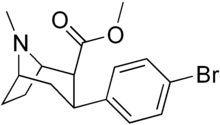 | |
| Identifiers | |
|---|---|
| |
| CAS Number | |
| PubChem CID | |
| CompTox Dashboard (EPA) | |
| Chemical and physical data | |
| Formula | C16H20BrNO2 |
| Molar mass | 338.245 g·mol−1 |
| 3D model (JSmol) | |
| |
| |
| | |
(–)-2β-Carbomethoxy-3β-(4-bromophenyl)tropane (RTI-4229-51, bromopane) is a semi-synthetic alkaloid in the phenyltropane group of psychostimulant compounds. First publicized in the 1990s, it has not been used enough to have gained a fully established profile. RTI-51 can be expected to have properties lying somewhere in between RTI-31 and RTI-55. It has a ratio of monoamine reuptake inhibition of dopamine > serotonin > norepinephrine (1.8:10.6:37.4 nM respectively) which is an unusual balance of effects not produced by other commonly used compounds (although RTI-121 is similar, but more DAT selective).[1] It has been used in its 76Br radiolabelled form to map the distribution of dopamine transporters in the brain.[2]
Modern research seems to confirm the above hypothesis.[3] However, earlier work produced more scattered results.[4] Based upon what is obvious from the table, RTI-31, RTI-51, and RTI-55 are all similarly potent TRIs.[5][6]
| Compound | [3H]CFT | [3H]DA | [3H]Nisoxetine | [3H]NE | [3H]Paroxetine | [3H]5-HT |
|---|---|---|---|---|---|---|
| Cocaine[8] | 89.1 | 275 cf. 241 | 3300 (1990) | 119 cf. 161 | 1050 (45) | 177 cf. 112 |
| WIN 35,065-2 | 23 | 49.8 | 920 (550) | 37.2 | 1960 (178) | 173 |
| WIN 35,428 | 13.9 | 23.0 | 835 (503) | 38.6 | 692 (63) | 101 |
| RTI-31 | 1.1 | 3.68 | 37 (22) | 5.86 | 44.5 (4.0) | 5.00 |
| RTI-113[9] | 1.98 | 5.25 | 2,926 | 242 | 2,340 | 391 |
| RTI-51 | 1.7 | ? | 37.4 (23) | ? | 10.6 (0.96) | ? |
| RTI-55 | 1.3 | 1.96 | 36 (22) | 7.51 | 4.21 (0.38) | 1.74 |
| RTI-32 | 1.7 | 7.02 | 60 (36) | 8.42 | 240 (23) | 19.4 |
Data in above table is from rats brains (1995). More recent work has advocated using cloned human transporters.